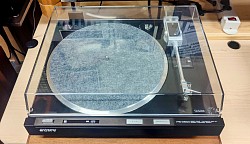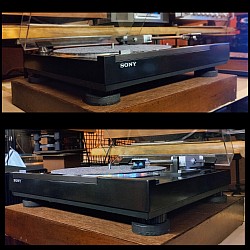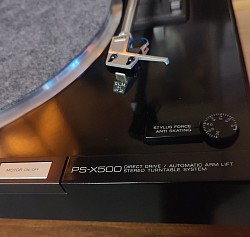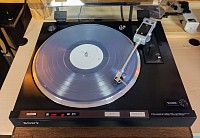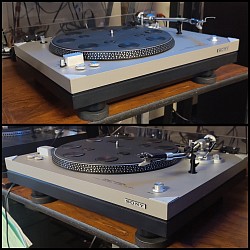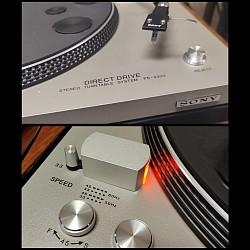Page 1 Stereo Turntables (NO shipping)
Sony PS-X500
('81-'83) $425
In excellent condition and obtained from the original owner, this Sony PS-X500 is an electronically controlled turntable with a direct-drive motor system and *Biotracer electronically controlled tonearm. A copy of the owner's operating manual is included.
Upon it's release in 1981, the retail price (without cartridge) for the PS-X500 was about $300 (today, that's equal to around $1145 with inflation). In our opinion, Sony made the smart decision to make this turntable operate in an essentially trouble-free semi-automatic fashion; at the end of play the arm lifts up and the unit powers off. This design eliminated the need for the arm to return thus avoiding additional and unnecessary electronic functions.
The piano gloss black finish is simply stunning. Beyond it's visual beauty, it has some really neat features such as an electronic stylus force and anti-skating adjustment and a muting system. Plus, the PS-X500 is easy to handle, simple to set up, and very user-friendly. An intricate engineering marvel, this turntable was built to last for many years beyond it's initial release in the early 80's. Today, some 44 years after it was introduced, this turntable still looks new and operates as if it just came out of the box.
The servo arm allows increasingly precise tracking, and allows benefits in greater stereo separation from a constantly monitored and corrected anti skate and reduced feedback (up to -3db) of when the stylus is making its way up and down edge warps, or poorer pressings (increasingly common with recent pressings). One of the great advantages of the Biotracer arm is its ability to adjust the weight electronically for just about any cartridge. The VTF (vertical tracking force) is also optimized and this results in much better overall bass response from the included (high end and highly regarded) ADC QLM 34 MKiii cartridge and new stylus tracking at an optimum 2.25 grams. Along with the needle in the down-position, the table has a muting-relay that kicks in when the needle is set down and lifted up from the record - saving your speakers and ears from unnecessary noise and feedback.
The plinth on the PS-X500 is made of dense resonance inert material that Sony pioneered specifically for dampening purposes SBMC (Sony Bulk Mould Compound), and the entire unit is placed on anti-resonant foam & felt pads. Essentially, the PS-X500 really has everything in all the right places, with a direct-drive motor (BSL) and a wow/flutter that measures 0.015% WRMS.
Complete specs:
Platter 12"aluminium alloy die-cast
Motor: Linear BSL motor
Drive system: direct drive
Control system: quartz lock control, magnedisc servo
Speeds: 33.33 and 45rpm
Wow and flutter: 0.015% WRMS
Signal to noise ratio: 78dB
Tonearm: electronic
Stylus force range: 0-3 grams
Cartridge shell weight: 5 grams
Cartridge weight range: 7.5 to 12.5g (17 grams with extra weight)
Dimensions: 17"W x 15.2"D x 4.73"H
Weight: 19 lbs
*Biotracer tonearm tech info:
The true novelty of the Sony PS-X500 is its Biotracer tonearm. It is a conventional J -shape tubular arm fitted with a universal four-pin plug-in headshell. Within it are the various drive motors and sensors that control arm motion.
When Sony designed the Biotracer tonearm, the purpose was to reduce/eliminate arm resonance electronically, as opposed to the mechanical damping methods employed by other arm manufacturers. The Biotracer arm movements are entirely controlled by coils (motors). Other coils within the arm are used to detect vibrations caused by unwanted resonances. If such vibrations occur, an electrical signal is generated by the coils, sent to a feedback circuit and an opposing force applied to the arm electronically to counteract the unwanted motion. This has the effect of controlling low frequency resonance to a great degree, with consequent associated benefits throughout the frequency spectrum, including providing extraordinary stereo separation.
Think of it like multi-axis image sensor stabilization for a camera except it's for the tonearm.
Sony PS-3300
('76-'78) SOLD
In excellent cosmetic condition, fully serviced and fully operational, this well built and attractive Sony PS-3300 is a semi-automatic turntable. Features include a gorgeous design, high quality specs, strobe and speed controls (trim pots.
This fine vintage turntable also comes with a new *Ortofon Omega cartridge and stylus is mounted on the original Sony headshell.
Designed to compete directly with Pioneer's PL-510, Sony challenged Pioneer with their PS-3300 at the same price point in 1976; you could buy the Pioneer's direct-drive manual unit or Sony's direct-drive semi-automatic unit. Essentially, Sony offered an auto-return arm and reject button at the same price with nearly identical specs and build quality.
The PS-3300 was an export-only model that was a mix between the Sony PS-2800's base structure and PS-3700's pitch controls and strobe.
Features include DC-Servo BSL motor, X-Tal Lock + Magnedisc and SBMC base. It also has a finely crafted direct-drive system with that brushless and slotless DC servo-controlled motor. Sony added a fine innovation with their speed monitoring system which was an electronic process using an 8-pole magnetic pick-up head and a pulse coated platter rim. Plus, as previously mentioned above, there's independent fine speed adjustments and a sensitive tonearm.
Sony's unique "lunar" platter mat was another idea that first appeared on the PS-3300. In essence, the design called for little air-filled pads to dampen the record's vibration and, apparently, it works. It didn't hurt that the mat, just by itself, is very cool indeed.
This beautiful turntable comes with the original clear acrylic dust cover and the original factory spring-loaded feet.
Weighing in at about 18 lbs, it's heavy enough to remind you that the PS-3300 is one of Sony's high quality turntables with great looks and reliable operation.
Essential specs:
Drive method: direct drive....
Motor: dc servo-controlled motor (brushless)....
Speeds: 33 and 45rpm....Wow and flutter 0.04% wrms
Signal to noise ratio: 65dB....
Cartridge weight range: 4 to 10g....
Dimensions: 18"W x 6.5"H x 14"D....
Weight: 18 lbs
*NOTE:
The Ortofon Omega is one of our favorite cartridges for several reasons and that's regardless of its attractive price. One of the reviews that we agree with stated: "the Ortofon Omega is a most underrated phono cartridge by those of the high end persuasion. It clearly outperforms all of the others in its price range and others costing much more. Its tracking of precisely 1.75 grams and advanced elliptical stylus shape renders an extremely flat extended frequency response that transcends the listener into a new dimension of sonic purity that its competition simply cannot touch.
++++++++++++++++++++++++++++++++++++++++++++
++++++++++++++++++++++++++++++++++++++++++++
